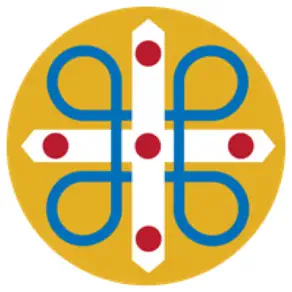What can Saint Birgitta say to us today?
Images
Remarkably, her message from the 14th century is highly relevant in our time. She also lived during a turbulent era that in many ways resembles our own, marked by war, political unrest, and a pandemic. In the Middle Ages, it was even harder to be a woman. Despite this, she became one of Sweden’s most famous individuals and was later named a patron saint of Europe.
She was courageous, stood up for her ideals of peace and reconciliation, rejected wastefulness, and patiently held on to her plan. Her background and strong relationship with God carried her through life’s difficulties and gave her the courage to speak truth to powerful men such as the king and the pope.
We know quite a lot about her life because Birgitta recorded her spiritual experiences in what became known as the Revelations. They were translated into Latin and received the Church’s approval. For a woman to be able to read and write was extremely rare at the time. But Birgitta came from a noble family where education was an ideal.
The Life of Saint Birgitta
Birgitta was born into a high-ranking noble family in Uppland around 1303. Her mother, who was related to the royal family, died when Birgitta was 11 years old. At the age of 13, her father arranged her marriage to Ulf Gudmarsson, a few years her senior, who would later become the lawman (similar to a governor) of Närke. According to her own words, the marriage was very happy. She gave birth to eight children and breastfed continuously for 15 years, all while managing the large estate of Ulvåsa north of Vadstena on her own, with extensive farmland and many staff. Ulf was often away on official duties. Her competence, piety, and good relationship with King Magnus led her to become a mentor to the young Queen Blanche, giving her political influence.
Birgitta’s strong faith in God shaped her entire life. She began having visions and divine revelations as early as age seven. She convinced Ulf to go on pilgrimages with her to Trondheim in Norway and to Santiago de Compostela in Spain. After returning from Spain in 1342, they moved to Alvastra Abbey (just south of Vadstena) at Birgitta’s request. Ulf died soon after, which became a turning point for Birgitta. She now devoted herself fully to her plan: founding a monastery for both monks and nuns, with a nun as the highest leader (abbess). She also envisioned building a grand abbey church in Vadstena, capable of welcoming thousands of pilgrims. She traveled to Rome to seek the pope’s approval. It took 20 years to get the green light to start the Bridgettine Order. Imagine such conviction and patience.
On her travels through Europe, Birgitta encountered a continent ravaged by war and the Black Death—a pandemic brought by sailors that swept through Europe for over 50 years and claimed at least a third of its population. For people of the Middle Ages, death was ever-present: disease, 50% child mortality, poverty, and bandits across the countryside. Imagine the courage it took for Birgitta to travel, leaving her family behind. By then, her children were grown or being raised in monastic schools. My slightly dry comment to you, Eva, is that she might have been seen as a bit superfluous and inconvenient at home—something Sandra highlights in her Birgitta monologue.
It was also a highly volatile time in both Sweden and Europe, with major political shifts and a thirst for revenge among those in power. Even so, Birgitta dared to advise both kings and popes and speak up on behalf of the poor before the ruling elite. She even tried—unfortunately without success—to prevent the outbreak of the Hundred Years’ War between England and France. Her message was clear: much of the world’s suffering is caused by human pride, greed, and lust for power. A message that still gives us pause today. Many disliked Birgitta in the Middle Ages—she was a woman who challenged norms and had a sharp tongue. Yet, she earned respect in most circles throughout her life.
After her final pilgrimage to Jerusalem, she died in Rome in 1373, at 70 years old. Her remains were placed in a reliquary and brought home to Sweden and Vadstena. The chest that carried her is preserved in the Monastery Museum in Vadstena. There, her daughter Catherine brought her vision to life, building the monastery and Abbey Church exactly according to Birgitta’s plans. Birgitta was canonized in 1391, 18 years after her death.
In the later Middle Ages, about 30% of the population made a pilgrimage at least once in their lifetime—many to Vadstena and the relics of Saint Birgitta in the Abbey Church. Saints were believed to be channels between God and humankind at the time. In the 16th century, during the Reformation, King Gustav Vasa banned pilgrimages and closed all monasteries in Sweden. But the Bridgettine Order still exists today, in Vadstena and in several places across Europe and the world. Many of the places where Birgitta lived and acted remain accessible to you as a pilgrim. She has inspired many throughout history and continues to do so today. Marika Markovits, the first female bishop of the Diocese of Linköping, has embraced Birgitta’s ideals in her ministry and chosen the motto: “Take courage – give life to the world.”
Contact
Address
Har du frågor kring leddragningar eller intressepunkter på St. Birgitta Ways kartguide. Kontakta då Emanuel Eriksson på Pilgrimscentrum
Email address
Vadstena Pilgrimscentrum
Organization logotype




